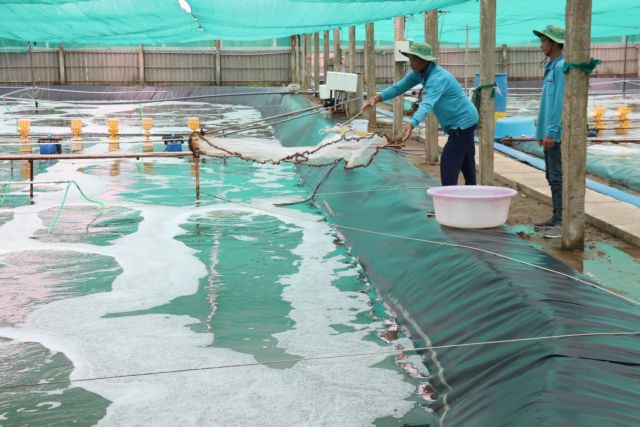 Society
Society


|
| Breeding shrimp under the two-stage industrial farming model in Bến Tre Province. — VNA/VNS Photo Công Trí |
BẾN TRE — More and more farmers in the Cửu Long (Mekong) Delta province of Bến Tre are breeding brackish water shrimp based on the two-stage industrial farming model since it reduces disease risk and offers higher yields.
White-legged shrimp are raised in two stages in ponds whose beds are covered with plastic sheets and surfaces with anti-sunshine nets. The ponds are also equipped with fans and pumps to generate oxygen for the water.
In the first stage, juvenile shrimp are bred in a smaller pond for about three to four weeks before being transferred to the main pond for intensive breeding in the second stage.
Đặng Văn Bảy of Thạnh Phú District’s Thạnh Hải Commune, who raises white-legged shrimp, has switched from traditional farming methods to the two-stage industrial farming model since 2015.
His output has quadrupled, he said.
Farmers adopting the model build a 1,500 sq.m main pond, a smaller one for the fry, a pond for filtering wastewater, and a covered anaerobic pond to generate biogas from solid waste generated from shrimp breeding.
This model treats waste thoroughly, protecting the environment and mitigating disease outbreaks.
Nguyễn Hoàng Nhũ, who has a 5ha shrimp farm in Ba Tri District’s Bảo Thạnh Commune, said the breeding of juveniles in the smaller pond reduces disease risks as their immunity is weak at this stage.
The model requires a large investment, and he himself had recently spent VNĐ1.7 billion (US$727,800) on a new 1.7ha farm, he said.
The province has more than 620ha under this model, twice the area a year ago, according to the province’s Fishery Sub-department.
Shrimp breeders who adopt the model get a yield of 70 – 80 tonnes per hectare per crop and an income of VNĐ700-800 million ($29,950-34,220), it said.
Shrimp farming is one of the province’s key economic sectors, and farmers raise shrimp using various models.
The province is reviewing and expanding its effective shrimp farming models, especially the two-stage industrial farming model, according to its People’s Committee.
Nguyễn Hữu Lập, vice chairman of the People’s Committee, said there are plans to expand the shrimp area under the two-stage industrial farming model to 1,200ha next year.
The province is encouraging farmers to breed shrimp using clean and organic models, he said.
Farmers mostly raise black tiger shrimp and white-legged shrimp.
In the first quarter they farmed black tiger shrimp on nearly 22,000ha and white-legged shrimp on 1,500ha, the province Department of Agriculture and Rural Development said.
The province plans that 10 per cent of its intensive shrimp farming areas will adopt good agricultural practice (GAP) standards next year.
It has many policies to support shrimp farming, investment in infrastructure, and development and adoption of advanced farming techniques. — VNS

.jpeg)


